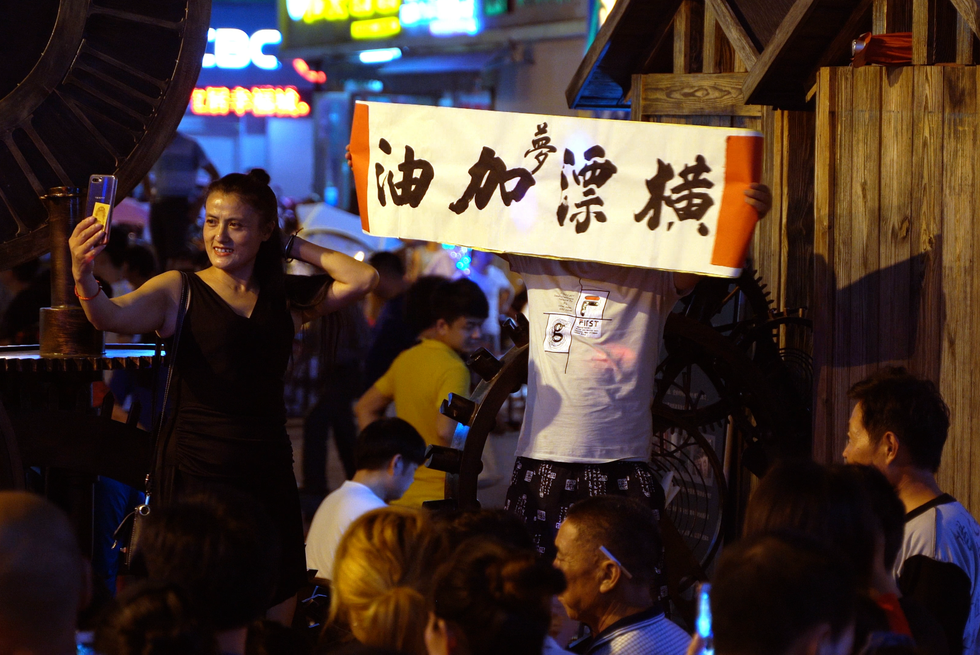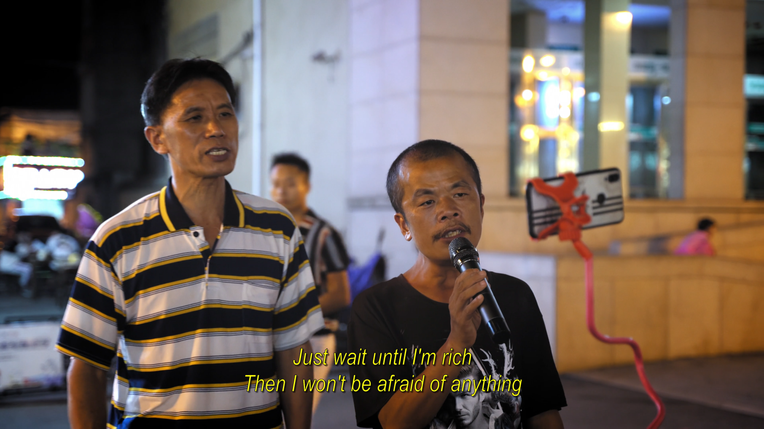Visions: The Labor Behind the Gaze in Hengdian Dreaming
From the Series: Hengdian Dreaming
From the Series: Hengdian Dreaming

Shayan Momin’s Hengdian Dreaming (2021) is many things at once: a visual collage of daily life in one of China’s filmmaking centers, an examination of the changing nature of digital and creative labor through livestreaming, and a meditation on the ways people create meaning together through sometimes grinding poverty and simultaneous elation at pursuing their artistic dreams. Skillfully weaving together the voices of several “Hengdian drifters” interspersed with clips of their time spent between work as background actors building side hustles as livestreamers or honing their crafts in the creative arts, the film immersively brings the viewer into the liminal space destined to part-time extras and aspiring artists drawn to the city of Hengdian, in Zhejiang Province, home to one of the world’s largest filmmaking studios.
The film opens with a woman sharing how she decided to travel to Hengdian—an idea that came to her in a dream. Finding life unsatisfying in her ordinary job, she heeded the calling of trying out something greater—for her, it was playing a part in a mythical martial arts drama. This story of finding life outside of Hengdian tedious and unfulfilling becomes a repeated backstory for many of those interviewed. While life as a Hengdian drifter is frequently toilsome, low-paying, and hard on the body, the sense of hope in possibly creating meaningful work often brings people back even when they drift away. These dreams become the added-value these actors create for themselves and each other as they cope with low wages, unpredictable work schedules, and sometimes grueling working conditions—and what keeps them around to try for more. Many of them have turned to livestreaming to scrape by, living off of ‘digital gifts’ from subscribers to put food on the table. Sharing snippets of life in Hengdian in exchange for digital payments, livestreamers offer tips on landing parts, behind-the-scenes stories of celebrities and their dogs, and peeks into the chaotic nightlife in Hengdian Drifters’ Square. At once capitalizing off of the allure of the city while also being driven by its hard realities to become livestreamers, the glamor portrayed to viewers is punctuated with confessions of “eating dirt and drinking rainwater” and visible expressions of weariness from the oft desperate hustle.
This is where Hengdian Dreaming goes beyond the retelling of hopes and dreams dashed by the harsh conditions of the entertainment industry and critically hones in on how emerging forms of digital entrepreneurship become just as tedious and exploitative as other forms of labor, even if framed as an opportunity for self-empowerment. The flexible forms of work that promise more independent and creative avenues for livelihoods through on-demand access to audiences reproduce the same alienation and frustration of other meaningless jobs—it’s just that now livestreamers have the apparent choice of performing for strangers in hopes of attracting gifts. One skilled calligrapher who resists livestreaming, as it is a waste of his time, proposes that it is what makes people in Hengdian act crazy—that doing so gives them a better shot at earning a meal online. After brainstorming several ideas on how to build his dream of being a stand-in calligrapher for accomplished actors with terrible handwriting, he too reluctantly gives livestreaming a shot only to find how truly difficult it is to do successfully.
Hengdian Dreaming brings the viewer through an empathetic look at workers’ lives in China’s digital entertainment economy and moves from surreal and hilarious scenes to bleakly existential commentary on the difficulties of surviving contemporary Chinese capitalism. What viewers may find familiar is the labor of livestreaming that has changed the terms of global participation in entertainment and the struggles to find meaning when available jobs are largely uninspiring. While the film focuses on a particular city in China, it touches on issues that transcend the specificity of place—the romanticization of creative industries and the unromantic effort they demand, the leveraging of aspirations for a better life in attracting low-wage workers to act as a standing reserve for such industries, and the fragmentation of social worlds through ever-smaller interactions in ever-widening digital spheres. Disrupting reductive portrayals of China as separate from the world with issues unique only to itself, Hengdian Dreaming illustrates a methodological choice of placing Chinese processes in conversation with global issues, along with a growing body of China Studies scholarship that frames phenomena in China as interlinked with globally occurring processes (e.g. Lee 2017; Byler 2022; Franceschini and Loubere 2022). Digital payment systems and platforms already existing in China have much to teach the rest of the world about how these shifts in socioeconomic life impact the lives of everyday people (see Momin 2023, forthcoming).

Beyond the implications for changes in area studies research, the film also contributes a refreshing twist on the traditional role of the gaze and perspective in ethnographic filmmaking. Far from the ‘fly on the wall’ approaches in many anthropological documentaries with long cuts and silent observation without apparent influence from the filmmaker, Momin is present throughout the film in large and small ways. We catch his role in conversations and see the actors insist on including him in their messages to viewers, how his position as an American outsider is convenient for people to explain how things work and make sense of their trajectories to each other at the same time, and we get glimpses into the conversations they have between one another in debating how to frame and engage with life in the Hengdian drift. The viewer’s gaze shifts not only between subject and filmmaker but also makes use of the perspective of the digital livestream experience by including scenes from a few successful livestreamers interacting with their audience, asking them to contribute gifts, share, and subscribe. The inundation with filters, frames, and live online commentary is portrayed visually in a way that mimics the actual experience of a livestream viewer inhabiting the chaotic space of switching between several platforms and apps simultaneously or across multiple devices. Throughout the film, we see how just about everyone is ready to take photos or film each other, including Momin, showing the panoptic effects of living in the landscape of live entertainment as the norm. The spectacle is more frequent and less eventful here, where everything seemingly has the potential to be spectacular. In contrast to early ethnographic films with silent, shocked, or shy subjects, in Hengdian, people often not only want to be filmed but film the filmmaker back, redirecting the gaze at the one who gazes upon them.
Finally, Hengdian Dreaming adds a visual depiction to the literature on cruel optimism that characterizes life under late capitalism as forcing a false sense of opportunity and longing that actually contributes to prolonged suffering (Berlant 2011). While many of the actors interviewed prefer their life of poverty and freedom in Hengdian to their slightly-less-poor past lives in traditional migrant labor, the film shows the wearing effects of constant striving for the promise of the ‘big break’ in their respective careers that never seems to come. In the course of their dreams being whittled away by continued struggle, we see how people are subject to all forms of social tropes from their peers, imposing narratives of not working hard enough or having the incorrect approach to entrepreneurship. At the same time, the cruel optimism that never seems to translate into flourishing does have the effect of making a hard life feel more worth living, at least being in community with others sharing the same risk of betting on their dreams.
Berlant, Lauren. 2011. Cruel Optimism. Durham, N.C.: Duke University Press.
Byler, Darren. 2022. Terror Capitalism: Uyghur Dispossession and Masculinity in a Chinese City. Durham, N.C.: Duke University Press.
Franceschini, Ivan, and Nicholas Loubere. 2022. Global China as Method. Cambridge: Cambridge University Press.
Lee, Ching Kwan. 2017. The Specter of Global China: Politics, Labor, and Foreign Investment in Africa. Chicago: The University of Chicago Press.
Momin, Shayan, dir. Hengdian Dreaming. 2021. 56 min.
———. 2023. “Lumpen Utopia: Money, Livestreaming, and Labor in Emerging Media Worlds.” Journal of Cultural Economy.